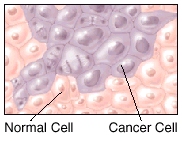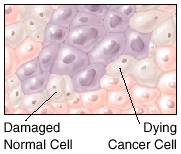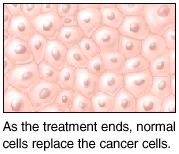Understanding Radiation Therapy
Understanding Radiation Therapy
Radiation therapy can help you in your fight against cancer. It uses high-energy X-rays or particles to kill cancer cells.
What is cancer?
Normally, cells in the body grow and divide in a controlled way when needed. But sometimes, things cause cells to change or mutate. They then start to grow and divide out of control. These are cancer cells. These cells multiply to form a lump called a tumor. Cancer cells can sometimes spread to other parts of the body. This is called metastasis.
How radiation therapy works
Radiation kills cancer cells slowly over time. The goal of this treatment is to kill as many cancer cells as possible. Radiation can also harm or kill normal cells that are close to the tumor. But damaged normal cells are more likely to be able to fix themselves than cancer cells. Over time, with daily radiation treatments, more cancer cells are killed than normal cells and the normal cells fix themselves. Cancer cells can't fix themselves as well as healthy cells. Over time, they die and are cleared by the body.
| |
|
| |
|
Types of radiation therapy
Different types of radiation therapy can be used to treat cancer.
External radiation
With external radiation, a machine aims beams of high-energy X-rays at the tumor. The goal of treatment is to kill all of the cancer cells, while affecting few normal cells. The machine can change position. That lets the X-ray beams go into your body from any angle. Newer types of external radiation therapy focus the radiation more precisely at the tumor. This helps to protect nearby normal tissues. These newer types include:
- 3-D conformal radiation therapy (3-D CRT)
- Intensity modulated radiation therapy (IMRT)
- Proton beam particle therapy
- Stereotactic radiation therapy
Internal radiation (brachytherapy)
Internal radiation uses radioactive pellets or implants. These are put right into or near the tumor. The implants put the radiation as close to the cancer cells as possible. This type of radiation travels only a short way. This helps focus the treatment on the cancer cells and spares nearby normal cells. Implants can be short-term or permanent.
Systemic radiation therapy
Some types of radiation therapy are given as a liquid that's swallowed. Or they are given as an injection (shot) of tiny particles into a vein (IV). The radiation is attached to a special antibody. This antibody binds to the cancer cells. It moves through the blood to reach tumors anywhere in the body. Once the radiation attaches to the cancer cells, it gives off local, controlled doses to kill the cancer cells.
Updated:
March 13, 2020
Reviewed By:
Dave Herold MD,Kimberly Stump-Sutliff RN MSN AOCNS,Lu Cunningham RN BSN



